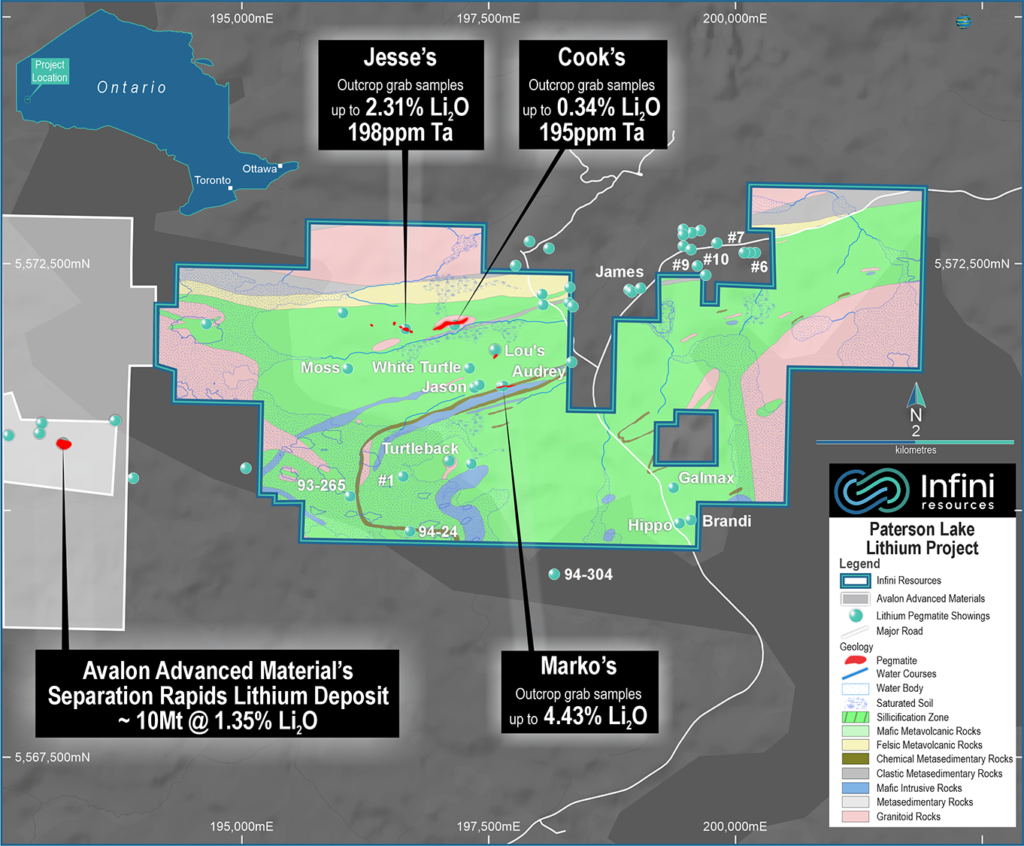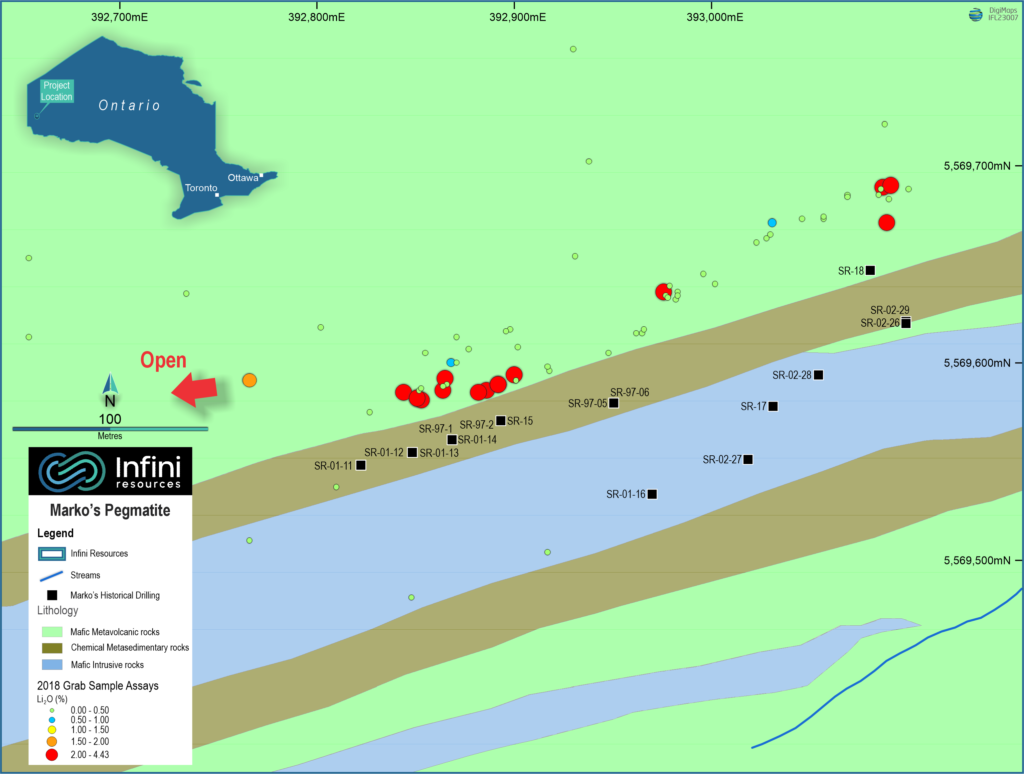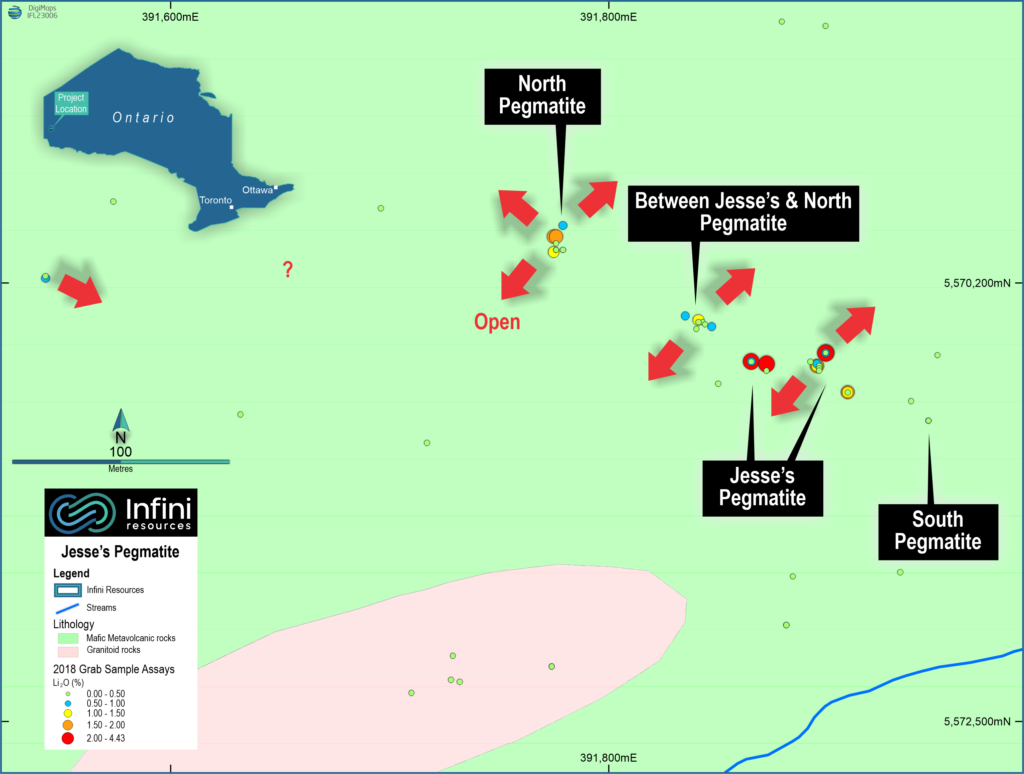
Paterson Lake
Project
Located in Ontario, it is located directly adjacent to Avalon Advanced Material’s Separation Rapids Lithium Deposit with ~10Mt @ 1.35% Li2O1.

Location and Tenure
The Paterson Lake Project comprises 106 mineral claims covering an area of approximately 12km2 located approximately 60km north of Kenora, to the northwest of Ontario, Canada. The project is situated on the Separation Lake Greenstone Belt (SLGB) which hosts the Separation Rapids Pegmatite Field (SRPF). The SRPF is known to contain numerous petalite pegmatites including the Big Whopper, Big Mack and Marko’s pegmatites. Avalon Advanced Materials Inc.’s (TSX:AVL) (Avalon) Separation Rapids Lithium Project includes the Big Whopper petalite pegmatite located approximately 3km west of Paterson Lake tenure within the same greenstone belt.
Geology and Prospectivity
The Paterson Lake Project tenure sits predominantly within the Archean SLGB of the Superior Province. The SLGB is composed of mafic metavolcanics with intercalated magnetite bearing banded iron formations, clastic metasediments, local mafic intrusive rocks and overlying felsic volcanic rocks. The SLGB is thought to represent an extension of the Bird River metavolcanic-metasedimentary belt of Manitoba, host to the world-class Li-Ta-Cs deposit owned by Tantalum Mining Corporation of Canada Limited (Tanco). The petalite-bearing pegmatite mineralisation at Paterson Lake is predominantly hosted in the mafic metavolcanic rocks of the SLGB which have undergone intense flattening and have a distinct penetrative foliation. Petalite is the dominant lithium ore-mineral, with minor Spodumene presence.
Historic geological documentation and mapping have indicated the presence of abundant rare-metal bearing pegmatites, including seven named petalite bearing pegmatites and up to 50 unnamed pegmatites that require investigation.
Other results of past work within the tenure includes:
- 11 historic drill holes drilled by Tanco, the majority of which were not assayed for lithium, notwithstanding that petalite was present;
- 11 historic litho-geochemical anomalies based on Li+Rb+Cs contents have been identified, of which only three anomalies have been partially tested with individual drill holes;
- seven historic enzyme leach B-horizon soil anomalies have been identified, with only a few of these anomalies partially tested with individual drill holes.
Planned Exploration
Funds raised from the Public Offer will be used to undertake a systematic exploration program including surface mapping, soil and trench sampling, geophysical surveys and potentially drilling on selected targets.
About the Project
- Contains a large distribution of lithium bearing pegmatites
- Two highly prospective and underexplored outcropping lithium pegmatite systems with grab samples up to 4.43% Li2O
- Historical diamond drilling
Focused exploration strategy:
- UAV aeromagnetic/LiDAR survey covering entire project on a 20m flight spacing
- Regional MMI soil survey covering entire project on a 200m x 200m grid pattern
- Microgravity over anomalous geochemistry and mineralised pegmatites to define drill targets
- Diamond drilling to test lithium mineralisation volume
Marko’s Pegmatite
- Mineralised strike length of 268m on surface and open to the West
- A total of 16 historical drill holes completed
- Numerous grab samples returning greater >2% Li2O;
- Previous exploration targeted tantalum mineralisation in the 1990’s with the true lithium potential not followed up

Jesse’s Pegmatite Swarm
- Current combined mineralised strike length of 190m on surface and open to the East & West
- Pegmatite distribution includes the North Dyke, North-Central Dykes, Central Dyke and South Dyke
- Deformed and sheared similar in appearance to those of Avalon’s Lithium property
- 4 grab samples returning greater >2% Li2O
Significant target features include:
- Pegmatites up to 30m wide in outcrop
- Never been drill tested

- Avalon’s Presentation April 2023, NI-43-101 Resource, non JORC, Measured, Indicated and Inferred Resources as at 23 May 2018. ↩︎